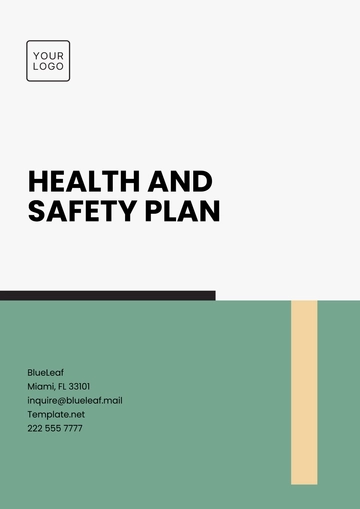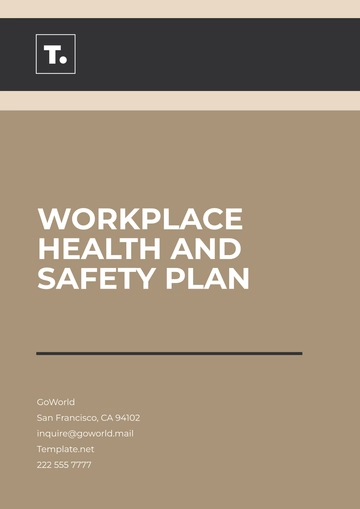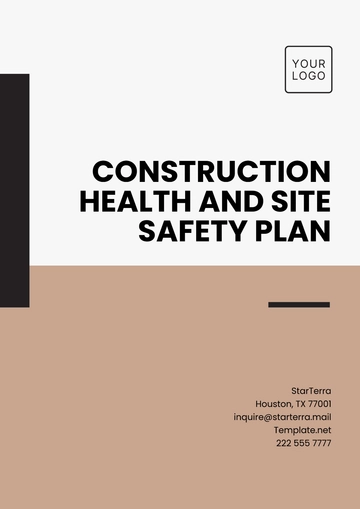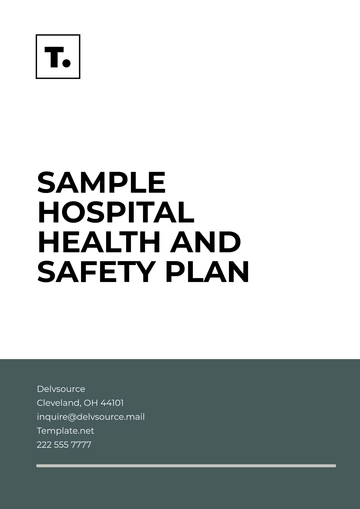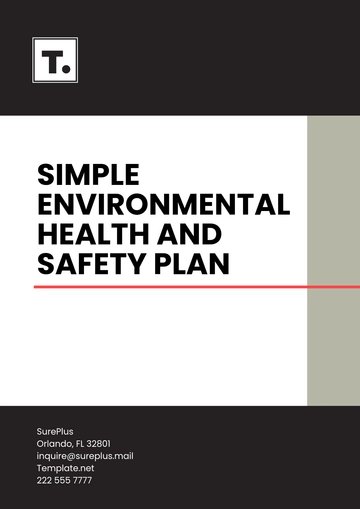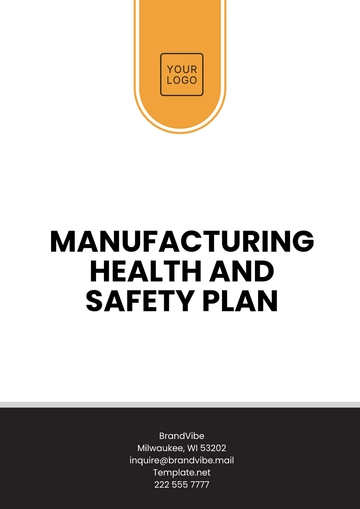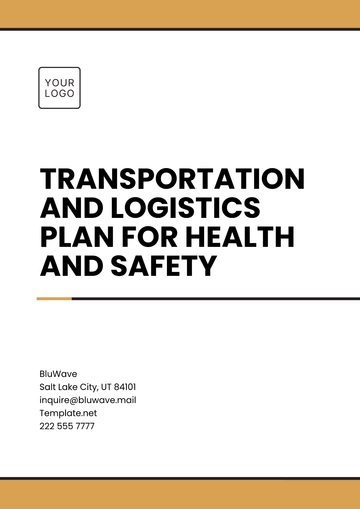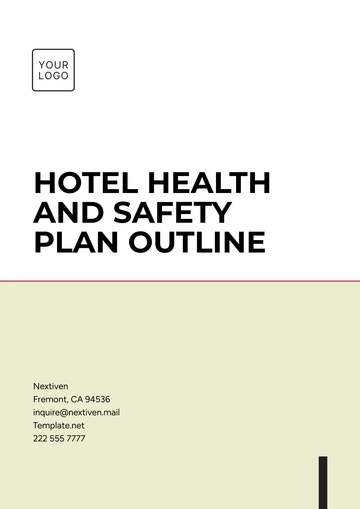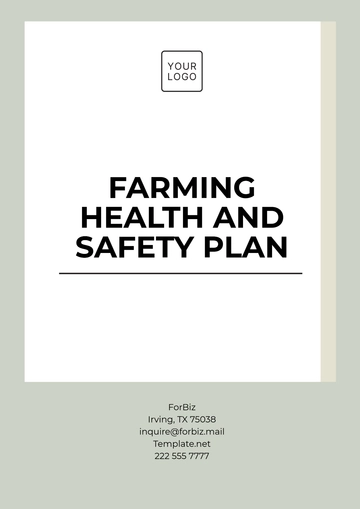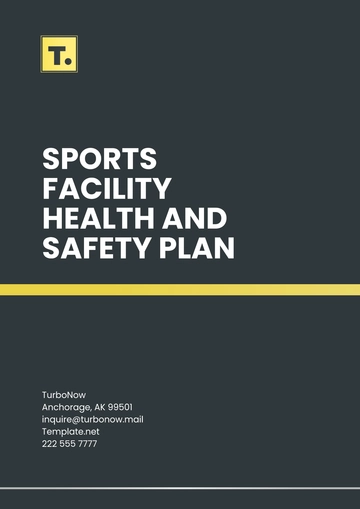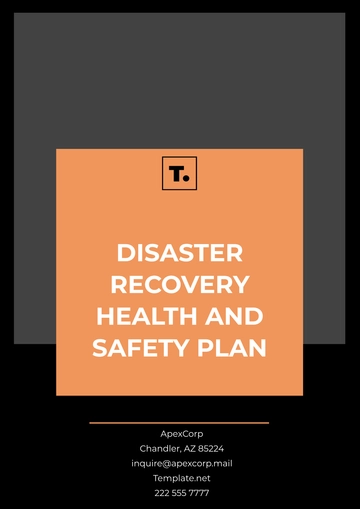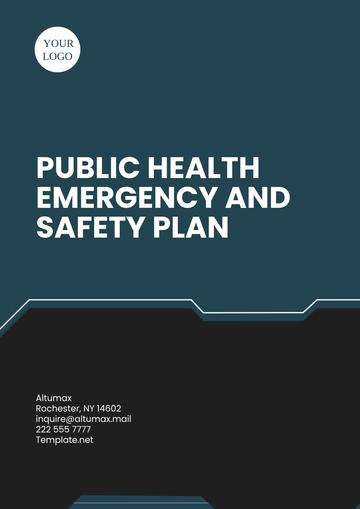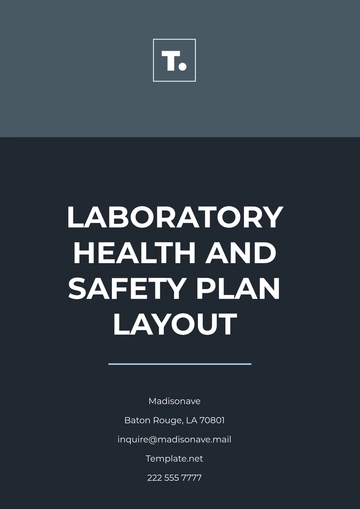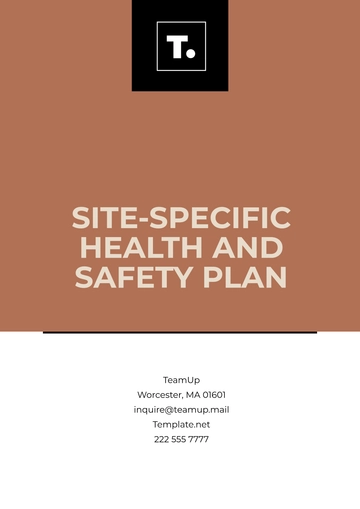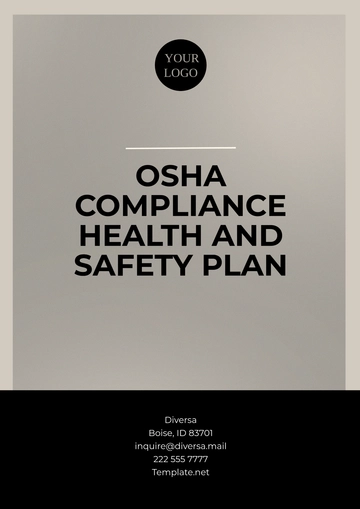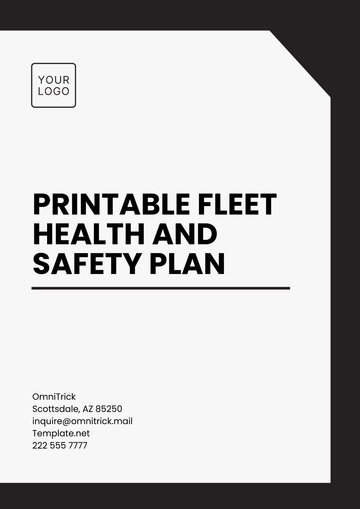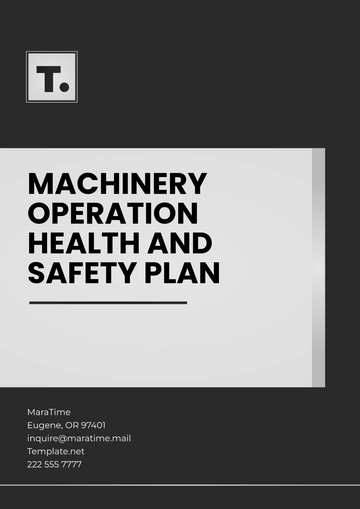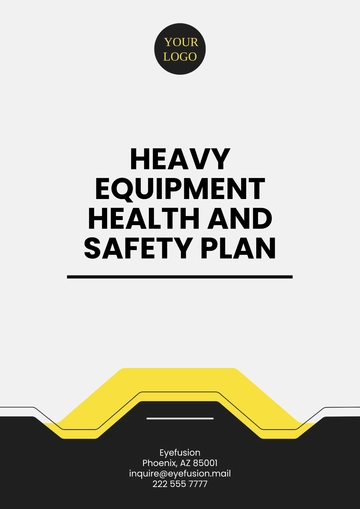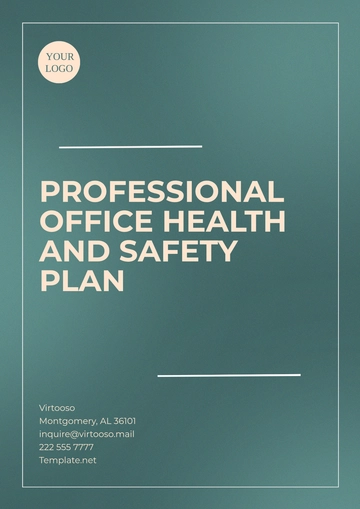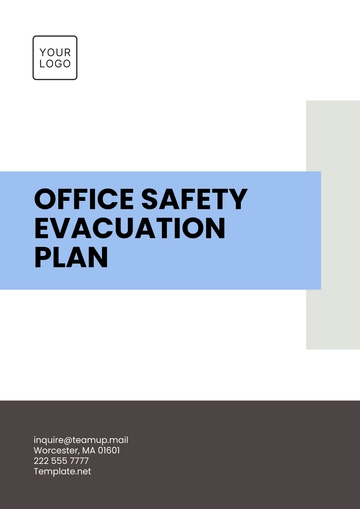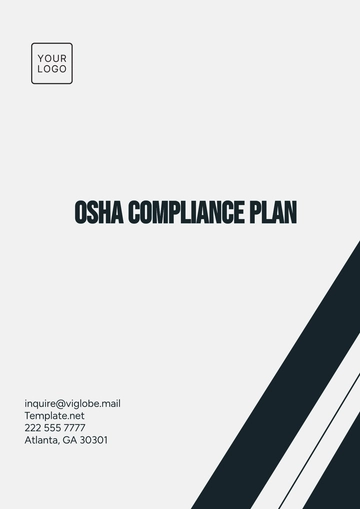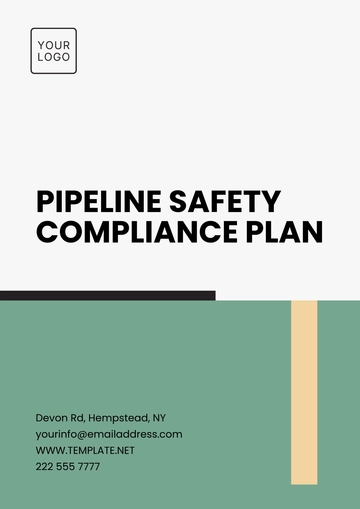Free Health & Safety Training Resource Allocation Plan

Allocation Plan
Document Overview
This document outlines the Health & Safety Training Resource Allocation Plan for [Your Company Name]. The plan aims to ensure that all employees are well-informed and trained in health and safety protocols relevant to their roles and responsibilities within the company. It covers the allocation of resources, including budget, personnel, and materials necessary for the effective implementation of health and safety training programs.
1. Company Information
This section provides essential details about [Your Company Name], including contact information and digital presence. It is intended to facilitate easy reference and communication for all matters related to the Health & Safety
Training Resource Allocation Plan.
Company Name:
Address:
Email:
Phone:
Website:
Social Media:
2. Training Program Outline
This section presents a comprehensive outline of the training program designed to enhance workplace health and safety at [Your Company Name].
Training Program Details
Subsection | Description | Key Points |
Training Objectives | Goals of the Training Program | Enhance knowledge of health and safety protocols Ensure compliance with local and international health and safety regulations Prepare employees to handle emergencies effectively |
Target Audience | Intended Recipients of the Training | All employees, with tailored programs for different departments Special focus on departments with elevated health and safety risks |
Training Modules | Specific Areas of Training | Basic Health and Safety Awareness Emergency Response Procedures Department-Specific Safety Protocols |
Each element of the training program is crafted to address the unique needs and risks associated with various roles within the company, ensuring comprehensive coverage of all relevant health and safety aspects.
3. Resource Allocation
This chapter outlines the comprehensive resource allocation for the Health & Safety Training program at [Your Company Name]. It includes a detailed budget allocation, a list of key personnel along with their responsibilities, and a summary of the material resources required for effective training. This structure ensures that all aspects of the program are adequately funded and managed, contributing to the overall success and efficiency of the training initiative.
Resource Allocation Overview:
3.1 Budget Allocation
A detailed financial plan is essential for the effective execution of the training program. The following table provides an estimated cost breakdown for various components of the training, ensuring transparency and accountability in financial planning
Item | Description | Estimated Cost |
Training Materials | Manuals, guides, digital content | [$1000] |
External Trainers | Specialist health and safety instructors | |
Venue & Equipment Rental | Training rooms, A/V equipment | |
Employee Time Compensation | Cost of employee time during training | |
Miscellaneous Expenses | Additional unforeseen expenses | |
Total | [$1000] | |
3.2 Personnel and Responsibilities
Efficient program execution requires clearly defined roles and responsibilities. The following table outlines the key personnel involved in the training program, their roles, and their specific duties.
Role | Name | Responsibilities |
Training Coordinator | [Your Name] | Overseeing training schedule and content creation. |
Health & Safety Officer | TBD | Ensuring compliance with safety regulations. |
Department Representatives | Various | Communicating department-specific needs. |
3.3 Material Resources
Material resources are critical for the practical aspects of the training. This includes training manuals, digital learning tools, and safety demonstration equipment, ensuring an engaging and effective learning experience.
Each element in this chapter contributes to the structured and effective implementation of the Health & Safety Training program, ensuring that [Your Company Name] meets its commitment to employee safety and regulatory compliance.
4.Training Schedule
The training schedule is a critical component of the Health & Safety Training program at [Your Company Name]. It outlines the timing and format of both the initial and ongoing training sessions. This schedule is designed to accommodate the varying needs of the employees and ensure the long-term retention of health and safety knowledge.
Training Schedule Overview:
4.1 Initial Training
The initial training provides a foundational understanding of health and safety protocols. This training is mandatory for all new and existing employees to ensure a uniform level of knowledge and preparedness across the organization.
Aspect | Detail |
Date | [Month Day Year] |
Duration | 2 weeks |
Location | [Your Company Address] |
Topics | Includes basic health and safety awareness, emergency response procedures, and department-specific safety protocols. |
Method | Combination of in-person sessions, hands-on demonstrations, and digital learning modules. |
Instructors | Mix of internal experts and external trainers specializing in various aspects of health and safety. |
4.2 Ongoing Training
Ongoing training ensures that employees remain updated with the latest health and safety practices and regulations. This is crucial for maintaining a safe and compliant workplace.
Type | Frequency | Description |
Quarterly Refresher Courses | Quarterly | Short sessions focused on key health and safety updates and reminders. |
Annual Comprehensive Reviews | Annually | In-depth review of all health and safety protocols, including any regulatory changes and best practices. |
Department-Specific Sessions | As needed | Targeted training addressing specific risks and protocols relevant to different departments. |
This structured approach to training scheduling ensures a continuous and comprehensive focus on health and safety, adapting to the dynamic needs of [Your Company Name] and its employees.
5. Monitoring and Evaluation
Monitoring and Evaluation are essential for assessing the effectiveness of the Health & Safety Training program at [Your Company Name]. It outlines the methods and tools used to gather data and feedback, allowing for continuous improvement of the training process. This chapter ensures that the training objectives are met and that the company remains compliant with health and safety standards.
Monitoring and Evaluation Overview:
5.1 Feedback Collection
Feedback from participants is vital to understanding the impact of the training and areas for improvement.
Method | Description | Frequency |
Post-Training Feedback Forms | Collect participant opinions on the content, delivery, and applicability of the training. | After each training session |
Focus Group Discussions | Conduct discussions with a select group of participants to gain in-depth insights. | Bi-annually |
5.2 Performance Metrics
Measuring performance metrics pre- and post-training provides quantitative data on the effectiveness of the training.
Metric Type | Description | Evaluation Period |
Knowledge Assessment | Tests or quizzes to measure knowledge gain. | Before and after each training session |
Behavioral Change Analysis | Observation and reports on changes in safety practices at the workplace. | Quarterly |
5.3 Regular Audits
Regular audits ensure ongoing compliance and the practical application of training in the workplace.
Audit Type | Description | Frequency |
Health & Safety Practice Audits | Systematic examination of the workplace to ensure adherence to taught safety protocols. | Annually |
Regulatory Compliance Audits | Review to ensure that trainingand practices align with current regulations. | Bi-annually |
Through this structured approach to monitoring and evaluation, [Your Company Name] can ensure that its Health & Safety Training program is effective, up-to-date, and continuously improving, thereby fostering a safer and more compliant workplace environment.
6. Amendments and Updates
The Health & Safety Training Resource Allocation Plan at [Your Company Name] is designed to be a dynamic document, adaptable to changes in the workplace environment, legal requirements, and stakeholder feedback. This section outlines the process and considerations for updating and amending the plan to ensure it remains effective and relevant.
6.1 Considerations for Amendments
Evolving Health and Safety Requirements
Monitoring Changes: Regularly monitor industry trends and best practices in health and safety.
Expert Consultation: Engage with health and safety experts to understand the implications of new research and techniques.
Regulatory Changes
Legal Compliance: Stay updated with local, national, and international health and safety laws and regulations.
Alignment with Standards: Ensure the training program aligns with standards set by relevant health and safety organizations.
Feedback Integration
Stakeholder Feedback: Actively seek and incorporate feedback from employees, trainers, and health and safety officers.
Effectiveness Review: Regularly assess the training program's effectiveness based on feedback and performance metrics.
6.2 Update Process
Regular Review Schedule
Annual Review: Conduct a comprehensive annual review of the training plan.
Emergency Updates: Implement immediate changes in response to urgent regulatory updates or significant health and safety incidents.
Responsibility and Approval
Assigned Team: Designate a team or individual responsible for monitoring changes and proposing updates.
Stakeholder Approval: Present significant amendments to key stakeholders for approval, including management and health and safety committees.
Communication of Changes
Transparent Communication: Ensure all changes are communicated clearly and promptly to all stakeholders.
Training Updates: Incorporate changes into the training program and materials as soon as possible.
6.3 Documentation
Change Log: Maintain a detailed log of all changes made to the plan.
Version Control: Use version control for the document to track historical changes and ensure the most current version is always in use.
By maintaining a flexible approach to amendments and updates, [Your Company Name] ensures that its Health & Safety Training Resource Allocation Plan remains a living document, responsive to the evolving needs of its workforce and the wider regulatory environment. This adaptability is key to fostering a safe, compliant, and well-informed workplace.
7. Approval
This Health & Safety Training Resource Allocation Plan for [Your Company Name] has been thoroughly reviewed, meets the required standards, and is ready for implementation:
Prepared by:
Email:
Phone:
Date:
- 100% Customizable, free editor
- Access 1 Million+ Templates, photo’s & graphics
- Download or share as a template
- Click and replace photos, graphics, text, backgrounds
- Resize, crop, AI write & more
- Access advanced editor
Discover the ultimate solution for streamlined Health & Safety Training Resource Allocation with Template.net's dynamic template. Effortlessly editable and fully customizable, this resource allocation plan template empowers you to optimize safety training distribution with precision. Harness the power of our AI Editor Tool for seamless customization. Upgrade your safety protocols today!
You may also like
- Finance Plan
- Construction Plan
- Sales Plan
- Development Plan
- Career Plan
- Budget Plan
- HR Plan
- Education Plan
- Transition Plan
- Work Plan
- Training Plan
- Communication Plan
- Operation Plan
- Health And Safety Plan
- Strategy Plan
- Professional Development Plan
- Advertising Plan
- Risk Management Plan
- Restaurant Plan
- School Plan
- Nursing Home Patient Care Plan
- Nursing Care Plan
- Plan Event
- Startup Plan
- Social Media Plan
- Staffing Plan
- Annual Plan
- Content Plan
- Payment Plan
- Implementation Plan
- Hotel Plan
- Workout Plan
- Accounting Plan
- Campaign Plan
- Essay Plan
- 30 60 90 Day Plan
- Research Plan
- Recruitment Plan
- 90 Day Plan
- Quarterly Plan
- Emergency Plan
- 5 Year Plan
- Gym Plan
- Personal Plan
- IT and Software Plan
- Treatment Plan
- Real Estate Plan
- Law Firm Plan
- Healthcare Plan
- Improvement Plan
- Media Plan
- 5 Year Business Plan
- Learning Plan
- Marketing Campaign Plan
- Travel Agency Plan
- Cleaning Services Plan
- Interior Design Plan
- Performance Plan
- PR Plan
- Birth Plan
- Life Plan
- SEO Plan
- Disaster Recovery Plan
- Continuity Plan
- Launch Plan
- Legal Plan
- Behavior Plan
- Performance Improvement Plan
- Salon Plan
- Security Plan
- Security Management Plan
- Employee Development Plan
- Quality Plan
- Service Improvement Plan
- Growth Plan
- Incident Response Plan
- Basketball Plan
- Emergency Action Plan
- Product Launch Plan
- Spa Plan
- Employee Training Plan
- Data Analysis Plan
- Employee Action Plan
- Territory Plan
- Audit Plan
- Classroom Plan
- Activity Plan
- Parenting Plan
- Care Plan
- Project Execution Plan
- Exercise Plan
- Internship Plan
- Software Development Plan
- Continuous Improvement Plan
- Leave Plan
- 90 Day Sales Plan
- Advertising Agency Plan
- Employee Transition Plan
- Smart Action Plan
- Workplace Safety Plan
- Behavior Change Plan
- Contingency Plan
- Continuity of Operations Plan
- Health Plan
- Quality Control Plan
- Self Plan
- Sports Development Plan
- Change Management Plan
- Ecommerce Plan
- Personal Financial Plan
- Process Improvement Plan
- 30-60-90 Day Sales Plan
- Crisis Management Plan
- Engagement Plan
- Execution Plan
- Pandemic Plan
- Quality Assurance Plan
- Service Continuity Plan
- Agile Project Plan
- Fundraising Plan
- Job Transition Plan
- Asset Maintenance Plan
- Maintenance Plan
- Software Test Plan
- Staff Training and Development Plan
- 3 Year Plan
- Brand Activation Plan
- Release Plan
- Resource Plan
- Risk Mitigation Plan
- Teacher Plan
- 30 60 90 Day Plan for New Manager
- Food Safety Plan
- Food Truck Plan
- Hiring Plan
- Quality Management Plan
- Wellness Plan
- Behavior Intervention Plan
- Bonus Plan
- Investment Plan
- Maternity Leave Plan
- Pandemic Response Plan
- Succession Planning
- Coaching Plan
- Configuration Management Plan
- Remote Work Plan
- Self Care Plan
- Teaching Plan
- 100-Day Plan
- HACCP Plan
- Student Plan
- Sustainability Plan
- 30 60 90 Day Plan for Interview
- Access Plan
- Site Specific Safety Plan
